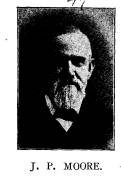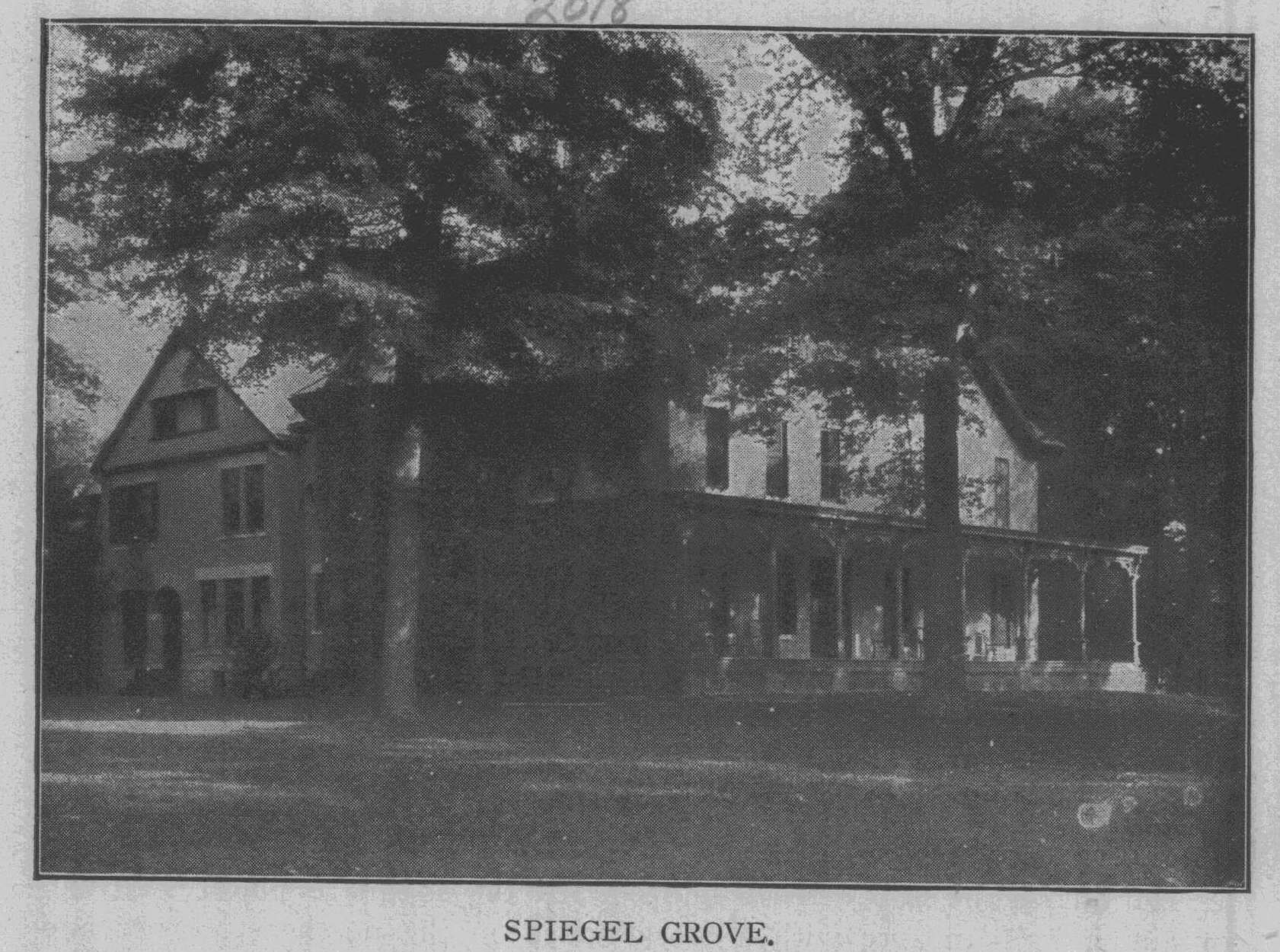Ohio History Journal
|
52 Ohio Arch. and Hist. Society Publications.
The name Croghansville, for the village, was probably first suggested by Josiah Meigs, Commissioner of the General Land Office, in a letter from Washington City, April 12, 1816, in which, among other words are these: "If it were left to me to name the town at Lower Sandusky I should name it in honor of the gallant youth, Col. Croghan -and should say it should be Croghansville. The name is still preserved in that of the school on the hill on the East Side, known as Croghansville School, as well as in the street abutting on Fort Stephenson.
REMARKS OF J. P. MOORE. I was born in Pennsylvania in 1829 and brought to the Black Swamp in, 1834. All my older brothers attended the Croghan celebra- |
|
|
|
construction of the fort and many incidents connected with its building and its defense against the British and Indians. The late David Deal, who was a member of Col. James Stephen- son's regiment of Ohio militia, told me that Col. Stephenson left them at Fort Meigs in January, 1813, to go to Lower Sandusky to build the fort which has ever since been called Fort Stephenson. I had always supposed that the first fort constructed on this site was built by Col. Stephenson's soldiers in January, 1813, but Col. Hayes has shown me a number of official records and a copy of an order issued by Brig. General William Irvine dated at Fort Pitt (now Pitts- burg) November 11, 1782, during the Revolutionary War, to Major Craig as follows: "Sir. I have received intelligence through various channels that the British have established a post at Lower Sandusky, etc., etc., also a copy of the treaty by which the reservation (present corporation limits of Fremont), two miles square, of which Fort Stephenson is about the center, was established by the treaty of Fort McIntosh as early as 1785 and continued in all subsequent treaties. Also an order from Governor Meigs of Ohio to Captain John Campbell dated Zanes- |
The Croghan Celebration. 53
ville, June 11, 1812. "You will
take with you the necessary tools for
building two blockhouses at
Sandusky." * * *. "You will build two
blockhouses and piquet them so as to
protect the United States trading
house and store at the place." * *
* "I expect you will meet at San-
dusky Major Butler, from Delaware with a
company to assist you."
Governor Meigs' letter shows that the
fort was built in 1812, but
the official record also shows that it
was abandoned for a short time
after Hull's surrender.
The old soldier Figley, of Columbiana
county, came here early in
February, 1813, and worked on the fort
until mustered out at Cleveland
on June 1st of that year. He related to
me how the pickets were drawn
by oxen from the vicinity of Stony
Prairie to the fort and points sharp-
ened and the posts set in the ground
close up one against the other.
Many of the oxen engaged in drawing them
died of starvation or were
devoured by the wolves howling around
the fort.
The company to which James Kirk belonged
came to the fort June
1, 1813, and worked here until the
arrival of the British and Indians
the day before the battle. James Kirk
himself had been detailed to carry
dispatches to Fort Seneca the day before
the battle so that he was not
present but came down early on the
morning of August 3 and helped
bury the British dead. He distinctly
heard the firing of the British can-
non and howitzers and noticed that some
discharges were louder than
others.
Kirk was 25 years old at that time and
after his discharge opened
a blacksmith shop in Lower Sandusky in
1818 and in 1828 went to Port
Clinton. He said that the well in the
fort was not a good one, so that
the garrison got their water from a
spring at the foot of Garrison
street, bringing it through a small gate
on the east side of the fort,
for which gate Kirk made the hinges.
I sent my son Theodore to visit James
Kirk in 188- and get a
description of the fort. Kirk said
"Mark off a square plat of ground
containing half an acre with a block
house on the northeast corner and
one in the northwest corner, this was
the original fort. In June, 1813,
when we came here the fort was found to
be too small. He said, "mark
off another square on the west side of
the old square and this you will
see will place the northwest blockhouse
in the center of the north line
of the enlarged fort. This was the
blockhouse from which "Old Betsy"
cleared the ditch when it was filled
with Col. Shortt's men. There was
a sealed log house in the new part
filled with biscuit for Perry's fleet.
This house was knocked down level with
the pickets by the British
cannon balls. The northeast blockhouse
was in the center of Croghan
and Arch streets. The center blockhouse
was about opposite the monu-
ment. The northwest angle of the fort
extended out about 15 feet into
High street. There were many extra guns
in the fort, as a company
of Pennsylvania soldiers had deposited
their guns there a few days be-
|
54 Ohio Arch. and Hist. Society Publications.
fore the battle on their way here from Fort Meigs. Their time being out, they were on their way home to be mustered out. The walls of the fort were made of logs, some round, some smooth on one side, half of the other logs averaging about 18 inches in thick- ness, all set firmly in the earth, each picket crowded closely against the other and all about ten feet high, sharpened at the top. The walls enclosed about one acre of ground. After Major Croghan took com- mand July 15, 1813, he had a ditch dug six feet deep and nine feet wide around the outside, throwing about one-half of the earth against the foot of the pickets and graded down to the bottom of the ditch; |
|
|
|
the rest of the earth was thrown on the outer bank and the depth of the ditch thus increased. Major Croghan had large logs placed on top of the wall of the fort, so adjusted that an inconsiderable weight would cause them to fall from their position and crush any who might be below. When the British landed opposite Brady's Island they sent a flag of truce under Col. Elliott who was met by Ensign Shipp on the ridge where the parsonage of St. John's Lutheran Church (which was for- merly the court house), now stands. This was eloquently described to me by Thomas L. Hawkins, the poet, preacher and orator. A ravine ran up from the river north of the fort through Justice street across the pike in a southwestern direction near the court house, |
The Croghan Celebration. 55
the British brought their cannon up this
ravine. They would load
their cannon and then run them up out of
the ravine and after dis-
charging them, back them down again to
reload out of range of the
guns of the fort. The next ravine south
of this ran up Croghan street,
turning to the southwest at High street,
thence northwest through the
northwest corner of the Presbyterian
church lot. This ravine formed
the north boundary of the plateau or
ridge on which Fort Stephens on
was located and on which ridge ran the
Harrison trail to the southwest
up through Spiegel Grove and on to Fort
Seneca. The next ravine
south of this extended between Birchard
avenue and Garrison street,
one branch ran towards the Methodist
church through the Dorr and
McCulloch property. It was from this
last named ravine that the British
Grenadiers made a feint against Capt.
Hunter's company just before Col.
Shortt made his assault on the northwest
corner of the fort.
Lieut. Col. Short and Lieut. J. G.
Gordon, of the 41st Regt. were
buried near the south entrance of the
high school building.
RECEPTION AT SPIEGEL GROVE.
Following the exercises of the afternoon
at Fort Stephenson, an
informal reception was held at Spiegel
Grove, to the out-of-town guests
of the city and the citizens at large.
Col. Webb C. Hayes, the prime
mover of the whole celebration, Mr. and
Mrs. Birchard A. Hayes and
Mrs. Fanny Hayes Smith cordially
received the guests on the great
piazza, where the Vice-President, the
Governor, the Governor's Staff
and the staff and line officers of the
Sixth Regiment were guests of
honor. Great numbers of persons moved
about through the beautiful
grounds, enjoying the music by the Light
Guard Band stationed in
front of the house, the superb weather
and the gay spectacle. The week
having been observed as Old Home Week,
many former residents of
Fremont were at hand to renew old
acquaintances and assist in doing
the honors of the place to the crowds of
strangers.
THE VENETIAN SPECTACLE.
With the falling of dusk the immense
crowds commenced to assemble
to witness the glories of as realistic a
Venetian night as was possible
to produce, following the plans
originated by Dr. Stamm, who has
several times viewed these spectacles in
Venice.
The river banks between the L. E. &
W. and State street bridges
were thronged with crowds, while the
special guests and those, by whose
efforts the day was a success, occupied
the guests' stand, built on the
water just north of the bridge.
More than a hundred boats and launches,
gaily decorated and illum-
inated, approached the reviewing stand,
presenting a beautiful sight
with their swaying colored lights on a
background of dark sky,

